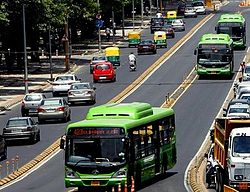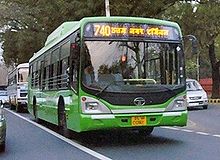- Delhi Bus Rapid Transit System
-
Delhi BRTS 
Info Transit type Rapid transit Number of lines Phase I: 7 (under construction) Website Delhi BRTS Operation Operator(s) Delhi Integrated Multi-Modal Transit System Limited Technical System length Phase I: 115.5 km (under construction) The Delhi Bus Rapid Transit System is a bus rapid transit being introduced in Delhi. a city in which buses cater to sixty percent of the city's transportation needs[citation needed]. Together with Delhi Metro and soon to be introduced Delhi Monorail and Delhi Light Rail, it will be part of an integrated multi-modal transport system. Introduction of bus rapid transit was sped up in time for the 2010 Commonwealth Games in Delhi.
Like other bus-rapid transit systems, Delhi BRT aims to make public transport more convenient. Delhi BRT is not grade-separated: the buses run at the same level as normal traffic and share the same traffic signals.
Contents
Introduction
In the last decade, a number of flyovers and underpasses were built to increase the mobility of commuters.[citation needed]. With the city’s buoyant economy, cars replaced buses on the roads and cyclists switched to motorcycles. Pedestrians became marginalized by increased numbers of vehicles on the road which also increased the pollution level, journey time and fuel consumption.
In 2002, Supreme Court issued an order to convert all diesel buses to compressed natural gas (CNG) to reduce air pollution. However, in less than a decade, the gains from the CNG program were lost: by August 2008, the average total suspended particulate (TSP) level in Delhi was 378 micrograms per cubic meter — approximately five times the World Health Organization’s (WHO) annual average standard[1]. It is estimated that over 3000 metric tons of air pollutants are emitted in Delhi [2].
The red colored buses are air-conditioned, while the green colored buses are not air-conditioned.
Traffic scenario in Delhi
The transportation network in Delhi is predominantly road based with 1,284 km of road per 100 km2. The number of vehicles on Delhi’s road increased by 212% in the 18 years from 1.923 million in 1991 to over 6 million by 2008. Roads in Delhi occupy 21% of the city, thus there is little scope of future expansion. The length of roads in Delhi increased from 22,487 km in 1991 to 31,183 km in 2008, a modest increase of 17% in the same period. To accommodate the increasing vehicular population, additional space is increasingly sought to be created either over or beneath the road, such as flyovers and underpasses. GNCTD built more than 15 flyovers on Ring Road to increase the throughput but not mobility: Ring Road has become completely signal-free, but not congestion-free.
Increasing vehicle population is co-related with road accidents: every year road accidents cost India about 3% of its gross domestic product, which was more than $1 trillion in 2007[3].
Delhi Metro, approved in 1998 with an aim to improve the traffic condition and mobility of commuters, operates around 90 trains and carrying approx. 80 000 passenger per day but can not completely replace the bus system on all routes, due to higher capital cost, low capital returns and large gestation period.
Corridors planned
A total 26 BRT corridors are planned, covering a total length of 310 km by the year 2020. This will be in addition to more than 400 km of metro train coverage by 2020 and further coverage by Monorail and Light Rail.
Phase Corridors Length (km) I (2005–2010) 7 115.5 II (2010–2015)7 3 28.0 III (2015–2020) 16 166.0 Total 26 310 Delhi BRT system
BRT means giving right of way to buses and safeguarding cyclists and pedestrians by encouraging lane driving on engineered road spaces along large and wide corridors and link them to metros and other main roads for easy access. Besides giving priority to buses, the system also provides dedicated lanes for pedestrian and non-motorized vehicles like cycles and rickshaws etc.
Implementation
In 2004, GNCTD appointed RITES and Indian Institute of Technology Delhi (IIT Delhi) for designing and implementing the first corridor from Dr. Ambedkar Nagar to Delhi Gate. RITES has been appointed the Project Management Consultant and TRIPP IIT Delhi the technical and conceptual advisors. In 2006, GNTCD established Delhi Integrated Multi-Modal Transit System (DIMTS), a Special Purpose Vehicle to oversee the establishment of public transport systems in Delhi. DIMTS is currently entrusted with the operation and maintenance of the existing corridor as the Corridor Manager.
In October 2006, construction work on the corridor started. The stretch from Dr. Ambedkar Nagar to Moolchand is under trial run since April 20, 2008.
Technical details
The first corridor start by BRT in Delhi, from Ambedkar Nagar to Delhi Gate, is 14.5 km long with right of way width varying from 28 meters to 51.5 meters. The bus lane is in the middle of the road with a width of 3.3 meters. Other motor vehicle lanes are is on the side of bus lane with a width of 6.75 meters. Separate lanes are provided for non-motorized vehicles and pedestrians.
Operation management
The corridor manager looks after operations and maintenance of the BRT Corridor, including traffic management, bus operation, public relations, enforcement, recovery of disabled vehicles, cleaning etc. The Operational Control Centre (OCC) at Kashmere Gate and a camp office at DTC Khan Pur Depot monitor the daily progress.
Third-party service providers meet specific requirements. 180 road marshals are deployed on the corridor to guide bus passengers, help children and old people to cross the road, manage traffic, instruct people to follow traffic rules and perform other corridor management activities.
The company also employs security guards at the bus platforms on a 24-hour basis and a crane to remove disabled vehicles from the corridor: since April 2008, on average 3 vehicles break down on the corridor each day and all disabled vehicles including buses are removed in about 10 minutes response time.
The company uses Passenger information system displays on all bus shelters. Global Positioning System is installed in the new low-floor buses on four routes – 419, 423, 521 and 522.
Traffic volume
Traffic volume on the BRT corridor is very high. The corridor is situated along some of the prime 'colonies' (urban districts) in South Delhi and is the main connecting road to the large commercial development in Gurgaon. On the stretch from Dr. Ambedkar Nagar to Moolchand, there are 6 key intersections, of which Chirag Delhi and Moolchand are the busiest ones. According to a DIMTS Survey, Chirag Delhi is one of the busiest junctions in Delhi.
More than 1.35 million vehicles cross the junction in a typical 16-hour day. Motorised vehicles consisting of cars, two wheelers and auto rickshaws constitute more than 90% of the vehicle traffic, of which the number of cars/Jeeps constitute around 35-40% of total motorized vehicles. These, however, carry only 15-20% of the total commuters. On the other hand, buses account only for 2.0-2.5% of total vehicles, but carry around 55-60% of the total commuters, thus using road space more democratically.
Approximately 200-250 buses move on Chirag Delhi Junction (the busiest section) during peak hour, catering to passenger load of about 11,000-12,000 on an average day. It has been observed that net throughput of all kinds of vehicles have significantly improved after the implementation of the BRT and bus and cycle transit time through the corridor has reduced[citation needed].
Commuter socioeconomic profile
According to a DIMTS commissioned socio-economic survey at BRT Corridor[citation needed], more than 60% of commuters use BRT Corridor mainly for work. Most of the respondents showed their discontent with the iprevious public transportation system. Respondents preferred to use their private vehicles due to inflexibility and unreliability of the bus system.
Mre than 50% of respondents desired timeliness of bus service, clean bus and well behaved staff and certainty of bus service. The research agency also enquired about the willingness of the respondents to use the BRT System. Interestingly, 85% of the respondents, who were currently not using public transport system, showed their willingness to use new BRT system if it is good.
References
Source
External links
Bus rapid transit in India Ahmedabad BRTS · Bangalore BRTS* · Chennai BRTS* · Chennai RBTW* · Coimbatore BRTS* · Delhi BRTS · Hyderabad BRTS* · Indore BRTS* · Jaipur BRTS · Kolkata BRTS† · Madurai BRTS* · Mumbai BRTS · Pinmpri-Chinchwad BRTS† · Pune BRTS† · Rajkot BRTS† · Surat BRTS† · Vijayawada BRTS ·- Planned · † Under construction
Categories:- Transport in Delhi
- Bus rapid transit in India
Wikimedia Foundation. 2010.

